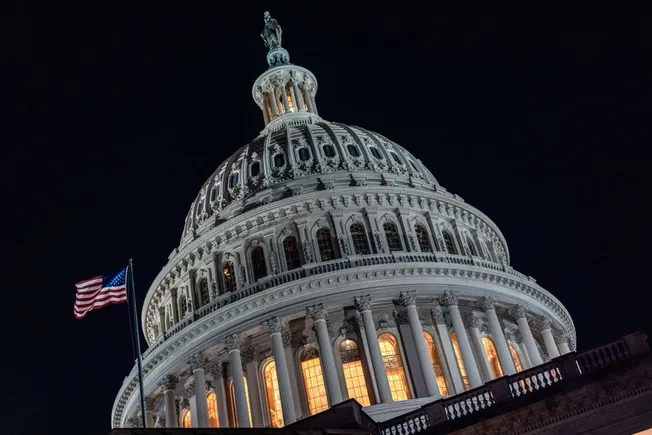
A bill that allows medical clinics to sell unproven treatments has been passed in Montana.
Under the legislation, doctors can apply for a license to open an experimental treatment clinic and recommend and sell therapies not approved by the Food and Drug Administration (FDA) to their patients. Once it’s signed by the governor, the law will be the most expansive in the country in allowing access to drugs that have not been fully tested.
The bill allows for any drug produced in the state to be sold in it, providing it has been through phase I clinical trials—the initial, generally small, first-in-human studies that are designed to check that a new treatment is not harmful. These trials do not determine if the drug is effective.
The bill, which was passed by the state legislature on April 29 and is expected to be signed by Governor Greg Gianforte, essentially expands on existing Right to Try legislation in the state. But while that law was originally designed to allow terminally ill people to access experimental drugs, the new bill was drafted and lobbied for by people interested in extending human lifespans—a group of longevity enthusiasts that includes scientists, libertarians, and influencers.
These longevity enthusiasts are hoping Montana will serve as a test bed for opening up access to experimental drugs. “I see no reason why it couldn’t be adopted by most of the other states,” said Todd White, speaking to an audience of policymakers and others interested in longevity at an event late last month in Washington, DC. White, who helped develop the bill and directs a research organization focused on aging, added that “there are some things that can be done at the federal level to allow Right to Try laws to proliferate more readily.”
Supporters of the bill say it gives individuals the freedom to make choices about their own bodies. At the same event, bioethicist Jessica Flanigan of the University of Richmond said she was “optimistic” about the measure, because “it’s great any time anybody is trying to give people back their medical autonomy.”
Ultimately, they hope that the new law will enable people to try unproven drugs that might help them live longer, make it easier for Americans to try experimental treatments without having to travel abroad, and potentially turn Montana into a medical tourism hub.
But ethicists and legal scholars aren’t as optimistic. “I hate it,” bioethicist Alison Bateman-House of New York University says of the bill. She and others are worried about the ethics of promoting and selling unproven treatments—and the risks of harm should something go wrong.
Easy access?
No drugs have been approved to treat human aging. Some in the longevity field believe that regulation has held back the development of such drugs. In the US, federal law requires that drugs be shown to be both safe and effective before they can be sold. That requirement was made law in the 1960s following the thalidomide tragedy, in which women who took the drug for morning sickness had babies with sometimes severe disabilities. Since then, the FDA has been responsible for the approval of new drugs.
Typically, new drugs are put through a series of human trials. Phase I trials generally involve between 20 and 100 volunteers and are designed to check that the drug is safe for humans. If it is, the drug is then tested in larger groups of hundreds, and then thousands, of volunteers to assess the dose and whether it actually works. Once a drug is approved, people who are prescribed it are monitored for side effects. The entire process is slow, and it can last more than a decade—a particular pain point for people who are acutely aware of their own aging.
But some exceptions have been made for people who are terminally ill under Right to Try laws. Those laws allow certain individuals to apply for access to experimental treatments that have been through phase I clinical trials but have not received FDA approval.
Montana first passed a Right to Try law in 2015 (a federal law was passed around three years later). Then in 2023, the state expanded the law to include all patients there, not just those with terminal illnesses—meaning that any person in Montana could, in theory, take a drug that had been through only a phase I trial.
At the time, this was cheered by many longevity enthusiasts—some of whom had helped craft the expanded measure.
But practically, the change hasn’t worked out as they envisioned. “There was no licensing, no processing, no registration” for clinics that might want to offer those drugs, says White. “There needed to be another bill that provided regulatory clarity for service providers.”
So the new legislation addresses “how clinics can set up shop in Montana,” says Dylan Livingston, founder and CEO of the Alliance for Longevity Initiatives, which hosted the DC event. Livingston built A4LI, as it’s known, a few years ago, as a lobbying group for the science of human aging and longevity.
Livingston, who is exploring multiple approaches to improve both funding for scientific research and to change drug regulation, helped develop and push the 2023 bill in Montana with the support of State Senator Kenneth Bogner, he says. “I gave [Bogner] a menu of things that could be done at the state level … and he loved the idea” of turning Montana into a medical tourism hub, he says.
After all, as things stand, plenty of Americans travel abroad to receive experimental treatments that cannot legally be sold in the US, including expensive, unproven stem cell and gene therapies, says Livingston.
“If you’re going to go and get an experimental gene therapy, you might as well keep it in the country,” he says. Livingston has suggested that others might be interested in trying a novel drug designed to clear aged “senescent” cells from the body, which is currently entering phase II trials for an eye condition caused by diabetes. “One: let’s keep the money in the country, and two: if I was a millionaire getting an experimental gene therapy, I’d rather be in Montana than Honduras.”
“Los Alamos for longevity”
Honduras, in particular, has become something of a home base for longevity experiments. The island of Roatán is home to the Global Alliance for Regenerative Medicine clinic, which, along with various stem cell products, sells a controversial unproven “anti-aging” gene therapy for around $20,000 to customers including wealthy longevity influencer Bryan Johnson.
Tech entrepreneur and longevity enthusiast Niklas Anzinger has also founded the city of Infinita in the region’s special economic zone of Próspera, a private city where residents are able to make their own suggestions for medical regulations. It’s the second time he’s built a community there as part of his effort to build a “Los Alamos for longevity” on the island, a place where biotech companies can develop therapies that slow or reverse human aging “at warp speed,” and where individuals are free to take those experimental treatments. (The first community, Vitalia, featured a biohacking lab, but came to an end following a disagreement between the two founders.)
Anzinger collaborated with White, the longevity enthusiast who spoke at the A4LI event (and is an advisor to Infinita VC, Anzinger’s investment company), to help put together the new Montana bill. “He asked if I would help him try to advance the new bill, so that’s what we did for the last few months,” says White, who trained as an electrical engineer but left his career in telecommunications to work with an organization that uses blockchain to fund research into extending human lifespans.
“Right to Try has always been this thing [for people] who are terminal[ly ill] and trying a Hail Mary approach to solving these things; now Right to Try laws are being used to allow you to access treatments earlier,” White told the audience at the A4LI event. “Making it so that people can use longevity medicines earlier is, I think, a very important thing.”
The new bill largely sets out the “infrastructure” for clinics that want to sell experimental treatments, says White. It states that clinics will need to have a license, for example, and that this must be renewed on an annual basis.
“Now somebody who actually wants to deliver drugs under the Right to Try law will be able to do so,” he says. The new legislation also protects prescribing doctors from disciplinary action.
And it sets out requirements for informed consent that go further than those of existing Right to Try laws. Before a person takes an experimental drug under the new law, they will be required to provide a written consent that includes a list of approved alternative drugs and a description of the worst potential outcome.
On the safe side
“In the Montana law, we explicitly enhanced the requirements for informed consent,” Anzinger told an audience at the same A4LI event. This, along with the fact that the treatments will have been through phase I clinical trials, will help to keep people safe, he argued. “We have to treat this with a very large degree of responsibility,” he added.
“We obviously don’t want to be killing people,” says Livingston.
But he also adds that he, personally, won’t be signing up for any experimental treatments. “I want to be the 10 millionth, or even the 50 millionth, person to get the gene therapy,” he says. “I’m not that adventurous … I’ll let other people go first.”
Others are indeed concerned that, for the “adventurous” people, these experimental treatments won’t necessarily be safe. Phase I trials are typically tiny, and they often involve less than 50 people, all of whom are typically in good health. A trial like that won’t tell you much about side effects that only show up in 5% of people, for example, or about interactions the drug might have with other medicines.
Around 90% of drug candidates in clinical trials fail. And around 17% of drugs fail late-stage clinical trials because of safety concerns. Even those that make it all the way through clinical trials and get approved by the FDA can still end up being withdrawn from the market when rare but serious side effects show up. Between 1992 and 2023, 23 drugs that were given accelerated approval for cancer indications were later withdrawn from the market. And between 1950 and 2013, the reason for the withdrawal of 95 drugs was “death.”
“It’s disturbing that they want to make drugs available after phase I testing,” says Sharona Hoffman, professor of law and bioethics at Case Western Reserve University in Cleveland, Ohio. “This could endanger patients.”
“Famously, the doctor’s first obligation is to first do no harm,” says Bateman-House. “If [a drug] has not been through clinical trials, how do you have any standing on which to think it isn’t going to do any harm?”
But supporters of the bill argue that individuals can make their own decisions about risk. When speaking at the A4LI event, Flanigan introduced herself as a bioethicist before adding “but don’t hold it against me; we’re not all so bad.” She argued that current drug regulations impose a “massive amount of restrictions on your bodily rights and your medical freedom.” Why should public officials be the ones making decisions about what’s safe for people? Individuals, she argued, should be empowered to make those judgments themselves.
Other ethicists counter that this isn’t an issue of people’s rights. There are lots of generally accepted laws about when we can access drugs, says Hoffman; people aren’t allowed to drink and drive because they might kill someone. “So, no, you don’t have a right to ingest everything you want if there are risks associated with it.”
The idea that individuals have a right to access experimental treatments has in fact failed in US courts in the past, says Carl Coleman, a bioethicist and legal scholar at Seton Hall in New Jersey.
He points to a case from 20 years ago: In the early 2000s, Frank Burroughs founded the Abigail Alliance for Better Access to Developmental Drugs. His daughter, Abigail Burroughs, had head and neck cancer, and she had tried and failed to access experimental drugs. In 2003, about two years after Abigail’s death, the group sued the FDA, arguing that people with terminal cancer have a constitutionally protected right to access experimental, unapproved treatments, once those treatments have been through phase I trials. In 2007, however, a court rejected that argument, determining that terminally ill individuals do not have a constitutional right to experimental drugs.
Bateman-House also questions a provision in the Montana bill that claims to make treatments more equitable. It states that “experimental treatment centers” should allocate 2% of their net annual profits “to support access to experimental treatments and healthcare for qualifying Montana residents.” Bateman-House says she’s never seen that kind of language in a bill before. It may sound positive, but it could in practice introduce even more risk to the local community. “On the one hand, I like equity,” she says. “On the other hand, I don’t like equity to snake oil.”
After all, the doctors prescribing these drugs won’t know if they will work. It is never ethical to make somebody pay for a treatment when you don’t have any idea whether it will work, Bateman-House adds. “That’s how the US system has been structured: There’s no profit without evidence of safety and efficacy.”
The clinics are coming
Any clinics that offer experimental treatments in Montana will only be allowed to sell drugs that have been made within the state, says Coleman. “Federal law requires any drug that is going to be distributed in interstate commerce to have FDA approval,” he says.
White isn’t too worried about that. Montana already has manufacturing facilities for biotech and pharmaceutical companies, including Pfizer. “That was one of the specific advantages [of focusing] on Montana, because everything can be done in state,” he says. He also believes that the current administration is “predisposed” to change federal laws around interstate drug manufacturing. (FDA commissioner Marty Makary has been a vocal critic of the agency and the pace at which it approves new drugs.)
At any rate, the clinics are coming to Montana, says Livingston. “We have half a dozen that are interested, and maybe two or three that are definitively going to set up shop out there.” He won’t name names, but he says some of the interested clinicians already have clinics in the US, while others are abroad.
Mac Davis—founder and CEO of Minicircle, the company that developed the controversial “anti-aging” gene therapy—told MIT Technology Review he was “looking into it.”
“I think this can be an opportunity for America and Montana to really kind of corner the market when it comes to medical tourism,” says Livingston. “There is no other place in the world with this sort of regulatory environment.”




















